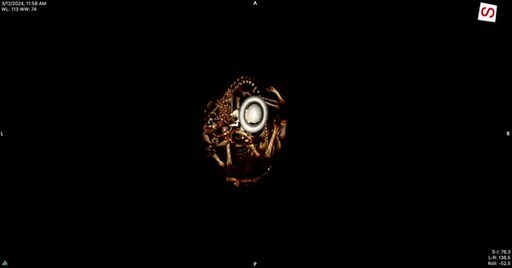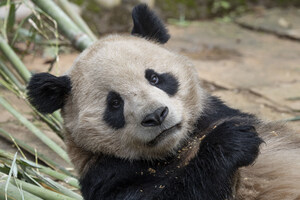Chick's Father Is Xol-Xol, One of the Last 22 California Condors Alive in 1982 and the First Brought Into Human Care as Part of the Recovery Program
SAN DIEGO, April 11, 2024 /PRNewswire/ -- San Diego Zoo Wildlife Alliance has welcomed the 250th California condor to hatch at the San Diego Zoo Safari Park. The chick's parents are Xol-Xol (pronounced "hole-hole")—the first California condor brought into human care under the California Condor Recovery Program in 1982—and Mexwe (pronounced "mex-weh"). More than 40 years since the California condor population dropped to a low of just 22 birds, this milestone is a significant success.
Before hatching, the egg was placed in an incubator to be closely monitored by wildlife care team. Due to a suspected malposition, the egg was taken to Paul Harter Veterinary Medical Center for computed tomography (CT) imaging. After examining the results, the chick's position was determined to not be of concern. The chick successfully pipped and was returned to Xol-Xol and Mexwe for hatching. The pair's nest is equipped with infrared cameras, allowing the team to monitor the hatching process around the clock. The chick, whose sex is not yet determined, hatched in the early morning hours of March 16 with the assistance of its very attentive parents and is doing well under their care. It was given the name Emaay (pronounced "eh-my"), a Kumeyaay word for "sky." Xol-Xol's name means "one of the sky people" in Chumash.
"Reaching this milestone feels incredible," said Nora Willis, senior wildlife care specialist, San Diego Zoo Wildlife Alliance. "Seeing the success that the San Diego Zoo Safari Park has had—and the success of the California Condor Recovery Program as a whole—is really inspiring. There's still a long way to go but being part of this and helping the species recover is life changing."
Xol-Xol, one of the last 22 condors remaining in 1982, was rescued from the Sespe Condor Sanctuary at three months old after being neglected by his parents, who were still rearing a chick from the previous year. He made his home at the San Diego Zoo Safari Park as the first California condor brought into human care under the California Condor Recovery Program. Xol-Xol has fathered 41 chicks since 1993, and many of those chicks have been reintroduced into their native habitat. Emaay is expected to join the native population in 2025.
In 1982, San Diego Zoo Wildlife Alliance was given permission to begin the first zoological propagation program for California condors. The program included the U.S. Fish and Wildlife Service, the California Department of Fish and Wildlife, the National Audubon Society, and the Los Angeles Zoo, among others. As a result of the innovative techniques developed by San Diego Zoo Wildlife Alliance and many partners, the resurgence of the California condor is a conservation success story. Today there are more than 560 living California condors, with over half free flying. The California condor is listed by the International Union for Conservation of Nature (IUCN) as Critically Endangered, with populations increasing. Major threats to their survival include lead poisoning, habitat loss and emerging diseases.
At least 50 California condors now join the population annually, and 12 to 15 chicks hatch in their native habitat every year. Condors hatched in human care are introduced across five reintroduction sites in the United States: one in northern Arizona at the Vermillion Cliffs and four in California, including Ventana Wilderness in Big Sur, Pinnacles National Monument, Yurok Ancestral Territory and Redwood National Park, and the Bitter Creek National Wildlife Refuge in the Los Padres National Forest. San Diego Zoo Wildlife Alliance and its partners in Mexico—Comisión Nacional de Áreas Naturales Protegidas, Secretaría de Medio Ambiente y Recursos Naturales, Instituto Nacional de Ecología y Cambio Climático and Espacios Naturales y Desarrollo Sustentable A.C.—have been managing a long-term program to restore California condors at a sixth site in the Sierra de San Pedro Mártir National Park in northern Baja California, Mexico, where condors lived until the mid-1950s.
About San Diego Zoo Wildlife Alliance
San Diego Zoo Wildlife Alliance, a nonprofit conservation leader, inspires passion for nature and collaboration for a healthier world. The Alliance supports innovative conservation science through global partnerships. Through wildlife care, science expertise and collaboration, more than 44 endangered species have been reintroduced to native habitats. Annually, the Alliance reaches over 1 billion people, in person at the San Diego Zoo and San Diego Zoo Safari Park, and virtually in 150 countries through media channels, including San Diego Zoo Wildlife Explorers television programming in children's hospitals in 14 countries. Wildlife Allies—members, donors and guests—make success possible.
Link includes:
- B-roll of parents Xol-Xol and Mexwe tending to their chick Emaay
- B-roll of wildlife care specialists examining the egg before it hatched
- Photos and video from the CT scan of the California condor egg
- Video interview with wildlife care specialist at the San Diego Zoo Safari Park
PERMITTED USE: Images and video(s) are provided to the media solely for reproduction, public display, and distribution in a professional journalistic non-commercial and non-sponsored context in connection with newspaper, magazine, broadcast media (radio, television) or internet media (ad enabled blog, webcasts, webinars, podcasts). Image(s) and video(s) may not be made available for public or commercial download, licensing or sale.
ADDITIONAL LIMITATION: Media acknowledges and agrees that San Diego Zoo Wildlife Alliance specifically does not grant a right to sublicense any image and/or video without the prior express written consent of San Diego Zoo Wildlife Alliance in each instance and at its sole discretion.
REQUIRED CREDIT AND CAPTION: All image and/or video uses must bear the copyright notice and/or be properly credited to the relevant photographer, as shown in the image metadata, and must be accompanied by a caption that makes reference to the San Diego Zoo and/or San Diego Zoo Safari Park. Any uses in which the image and/or video appears without proper copyright notice, photographer credit and a caption referencing the San Diego Zoo, San Diego Zoo Safari Park, and/or San Diego Zoo Wildlife Alliance are subject to paid licensing.
AP PERMITTED USE: Specific to the Associated Press ("AP") only, San Diego Zoo Wildlife Alliance has provided to the AP one or more photograph(s) and/or video(s) for distribution by the AP to its subscribers and customers solely for editorial publication. San Diego Zoo Wildlife Alliance is the sole copyright owner of the photograph(s) and/or video(s) furnished to AP for editorial publication by AP and its subscribers and customers in all media now known or hereafter created. Said content is a factually accurate rendering of what it depicts and has not been modified or augmented except for standard cropping and toning.
CONTACT:
San Diego Zoo Wildlife Alliance
Public Relations
619-685-3291
[email protected]
sdzwa.org
PRESS ROOM: https://sandiegozoowildlifealliance.org/PR/condor-250
SOURCE San Diego Zoo Wildlife Alliance

WANT YOUR COMPANY'S NEWS FEATURED ON PRNEWSWIRE.COM?
Newsrooms &
Influencers
Digital Media
Outlets
Journalists
Opted In







Share this article